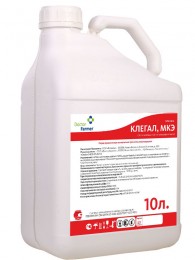
This chemical product is at the registration stage
| Eligible crops: | Sunflower, Beet, Colza, Leguminous crops, Potato, Flax |
| Application: | Herbicides |
| Harmful sites: | Annual and some perennial weeds |
| Active materials: | Clethodim + haloxyfop-R-methyl |
| Concentration: | 130 + 80 g/l |
| Chemical family: | Aryloxyalkanecarboxylic acids + cyclohexanediones |
| Formulation: | oil emulsion concentrate, OEC |
| Packing: | canister 5, 10 and 20 l |
|
|
Culture |
Harmful object |
Method, processing time, application features |
Waiting period (number of treatments) |
|
0,4 |
Sugar beet, spring and winter rapeseed, soybeans, sunflower (for seeds and oil) |
Annual cereal weeds |
Spraying crops in the phase of 2-6 leaves of weeds, regardless of the phase of crop development. Working fluid consumption - 200-300 l/ha |
60(1) |
|
0,8 |
Perennial cereals, including wheatgrass, weeds |
Spraying crops when the height of creeping wheatgrass is 10-20 cm, regardless of the phase of crop development. Working fluid consumption - 200-300 l/ha |
||
|
0,4 |
Peas, buckwheat, lupine, alfalfa, |
Annual cereal weeds |
Spraying crops in the phase of 2-6 leaves of weeds, regardless of the phase of crop development. Working fluid consumption - 200-300 l/ha |
60(1) |
|
0,8 |
Perennial cereals, including wheatgrass, weeds |
Spraying crops when the height of creeping wheatgrass is 10-20 cm, regardless of the phase of crop development. Working fluid consumption - 200-300 l/ha |
||
|
0,4 |
Fiber flax |
Annual cereal weeds |
Spraying crops in the 2-4 leaf phase of weeds (in the “herringbone” phase of the crop). Working fluid consumption - 200-300 l/ha |
-(1) |
|
0,8 |
Perennial cereals, including wheatgrass, weeds |
Spraying crops when the height of creeping wheatgrass is 10-15 cm (in the “herringbone” phase of the crop). Working fluid consumption - 200-300 l/ha |
||
|
0,4 |
Oil flax |
Annual cereal weeds |
Spraying crops in the 2-4 leaf phase of weeds (in the “herringbone” phase of the crop). Working fluid consumption - 200-300 l/ha |
56(1) |
|
0,8 |
Perennial cereals, including wheatgrass, weeds |
Spraying crops when the height of creeping wheatgrass is 10-15 cm (in the “herringbone” phase of the crop). Working fluid consumption - 200-300 l/ha |
||
|
0,4 |
Potato |
Annual cereal weeds |
Spraying of plantings in the phase of 2-6 leaves of weeds, regardless of the phase of crop development. Working fluid consumption - 200-300 l/ha |
54(1) |
|
0,8 |
Perennial cereals, including wheatgrass, weeds |
Spraying of plantings when the height of creeping wheatgrass is 10-20 cm, regardless of the phase of crop development. Working fluid consumption - 200-300 l/ha |
(*) This chemical product is at the registration stage for these crops
Mechanism of action
Klegal is a selective systemic herbicide. Both active substances inhibit the biosynthesis of fatty acids as a result of inhibition of acetyl-CoA carboxylase. Haloxyfop-R-methyl enters the plant through leaves and roots and is hydrolyzed to haloxyfop-R, which moves into meristem tissues and inhibits their growth. Cletodim is quickly adsorbed and moves from treated leaves to the root system and growth points of weeds.
We will contact you shortly.